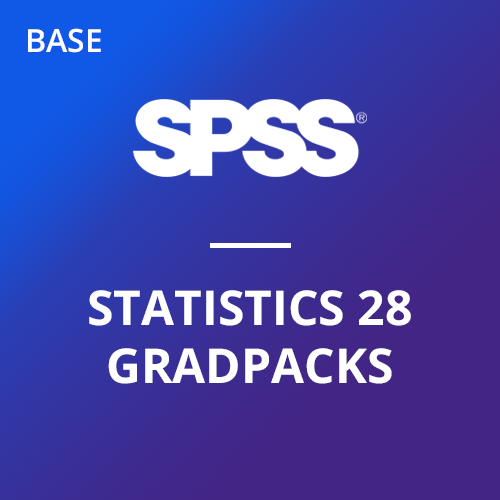
- Ibm spss statistics base mac os#
- Ibm spss statistics base install#
- Ibm spss statistics base series#
Compare means – Choose whether to use harmonic or geometric means test linearity compare via independent sample statistics, paired sample statistics or one-sample t test.
 Descriptive ratio statistics – Coefficient of dispersion, coefficient of variation, price-related differential and average absolute deviance.
Descriptive ratio statistics – Coefficient of dispersion, coefficient of variation, price-related differential and average absolute deviance. 
Descriptives – Central tendency, dispersion, distribution and Z scores.Frequencies – Counts, percentages, valid and cumulative percentages central tendency, dispersion, distribution and percentile values.Crosstabulations – Counts, percentages, residuals, marginals, tests of independence, test of linear association, measure of linear association, ordinal data measures, nominal by interval measures, measure of agreement, relative risk estimates for case control and cohort studies.A wider range of R programming options enables developers to use a full-featured, integrated R development environment within SPSS Statistics.Enterprise users can access SPSS Statistics using their identification badges and badge readers.
 Stata 13 users can import, read and write Stata 9-13 files within SPSS Statistics. Enhanced categorical principal component analysis (CATPCA) capabilities. Completely redesigned web reports offer more interactivity, functionality and web server support. Embed analytics into the enterprise to speed deployment and return on investment. The Generalized Spatial Association Rule (GSAR) finds associations between spatial and non-spatial attributes. The Spatio-Temporal Prediction (STP) technique can fit linear models for measurements taken over time at locations in 2D and 3D space. Integrate, explore and model location and time data, and capitalize on new data sources to solve new business problems.
Stata 13 users can import, read and write Stata 9-13 files within SPSS Statistics. Enhanced categorical principal component analysis (CATPCA) capabilities. Completely redesigned web reports offer more interactivity, functionality and web server support. Embed analytics into the enterprise to speed deployment and return on investment. The Generalized Spatial Association Rule (GSAR) finds associations between spatial and non-spatial attributes. The Spatio-Temporal Prediction (STP) technique can fit linear models for measurements taken over time at locations in 2D and 3D space. Integrate, explore and model location and time data, and capitalize on new data sources to solve new business problems. Ibm spss statistics base series#
Use the Temporal Causal Modeling (TCM) technique to uncover hidden causal relationships among large numbers of time series and automatically determine the best predictors. Gain deeper predictive insights from large and complex datasets. Be sure you have all the add-ons needed for your course or dissertation! The Base version does not include any add-ons and you may not purchase them separately or at a later time. No limitation on the number of variables or cases. For MacOS 10.10 (Yosemite), please see below. Ibm spss statistics base mac os#
Runs on Windows and Mac OS 10.8 (Mountain Lion) computers and 10.9.
Ibm spss statistics base install#
Eliminate variability in data due to language-specific encoding and view, analyze and share data written in multiple languages using built-in Unicode support.You may install the software on up to two (2) computers. Access, manage and analyze any kind of data set including survey data, corporate databases, data downloaded from the web and IBM Cognos Business Intelligence data. Quickly change information and statistics in graphs for new levels of understanding, and convert a table to a graph with just a few mouse clicks. Use pre-built map templates to generate a geographic or demographic analysis that can provide critical information for decision making. Create high-end charts and graphs to aid analysis and reporting and identify new insights in your data. Distribute and manipulate information for ad hoc decision-making using report online analytical processing (OLAP) technology. Build a chart once, and then use those specifications to create hundreds more just like it. Drag and drop variables and elements onto a chart creation canvas and preview the chart as it is being built. Create commonly used charts, such as scatterplot matrices, histograms and population pyramids, more easily. Open multiple data sets within a single session to save time and condense steps. Set up data dictionary information (for example, value labels and variable types) and use it as a template to prepare all of your data for analysis faster. Identify and eliminate duplicate cases and restructure your data files prior to analysis. Use SPSS Statistics Base with other modules, such as IBM SPSS Regression and IBM SPSS Advanced Statistics, to more accurately identify and analyze complex relationships. Apply Monte Carlo simulation techniques to build better models and assess risk when inputs are uncertain. Predict numerical outcomes and identify groups using factor analysis, cluster analysis, linear regression, ordinal regression, discriminant analysis and Nearest Neighbor analysis.  Carry out a wide range of descriptive procedures including crosstabulations, frequencies, compare means and correlation. A comprehensive range of statistical procedures
Carry out a wide range of descriptive procedures including crosstabulations, frequencies, compare means and correlation. A comprehensive range of statistical procedures








 0 kommentar(er)
0 kommentar(er)
